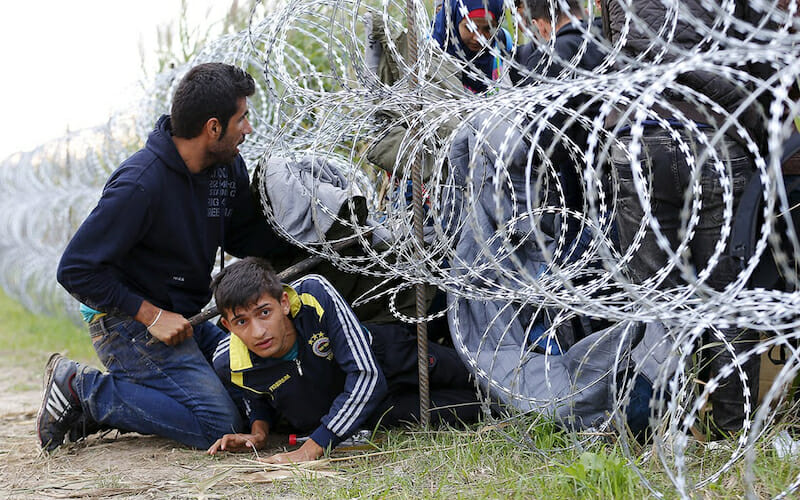
Only Immigration Can Save Europe’s Population
More and more European governments, even those that originally supported a generous and values-based immigration policy, have decided to reduce the number of people they will allow to enter their countries after the surge in 2015. Yet, refugees exist and will continue to multiply as long as there is war, political persecution, and climate-induced environmental disasters. They need to go somewhere, and to say ‘NIMBY’ is not a very constructive approach to trying to solve this problem.
On one hand, one can say it’s indeed not the duty of any European country to solve the situation single-handedly. Why should Germany pull a heavier weight when few other countries are prepared to do their part? And it’s safe to say that ruling political parties in ‘generous’ countries like Germany and Sweden paid a dear political price for being ‘open’ to im,igrants in the first place.
On the other hand, one can lament that these governments are giving up on their humanitarian principles.
Having to deal with the compounding effects of instability and conflicts in the MENA region is not something I’d wish on anyone. But even if our elected politicians didn’t run for office (or get into politics in the first place) to deal with this mammoth problem, they have to. Better get used to it. New conflicts emerge, and for all we know the next powder keg could be much closer to home. Perhaps Turkey, Ukraine or even Russia? New crises can develop due to extreme weather conditions due to climate change. And assuming help must come from somewhere, there is no accounting trick in the world that can hide the fact that receiving immigrants costs basically everyone.
However, there is another thing that costs? Investment.
The perceived difference is that contrary to paying to help people get shelter and a chance for a decent life, ‘investment’ is undertaken with the prospect of getting a return in the future. There is a (hopefully consciously pondered) risk of losing the money, but nobody makes an investment without at least a considerable chance of a decent return.
However, spending money on immigration offers the potential of acquiring new consumers as well as employees, entrepreneurs and taxpayers, who could all provide a decent return to a nation’s economy down the road.
So why doesn’t Europe reframe the huge undertaking of accommodating refugees and other non-European immigrants as the greatest — although maybe also the riskiest — investment case in modern history?
The foremost reason for not doing so is very likely racism, or at least the fear of the unknown and a reluctance for cultural change that concerns all of us. But as any historian will tell you, cultures are always in flux and a static definition of who we are, handed down from some vague moment in the past when everything was harmony and ‘the way it’s always been’ is simply an illusion.
So while it is impossible to ignore the cultural baggage of fear and reluctance when shaping immigration policies, it would be helpful to see it more as an economic opportunity (with the associated upshot potential) that we all engage in daily.
After all, a lot of people — and governments — take massive risks with their (or others’) assets. It seems weird that we should be so reluctant to invest in a group of people who more often than not are motivated, industrious and skilled, and have the potential to boost our economies. I would echo author Philippe Lagrain’s 2006 quote: “your country needs them.” Immigrants are today the only plausible salvation for Europe’s slowly decaying rural areas.
Let’s take one example: Sweden.
This spacious country in the North, is often praised for its progressive welfare politics, has some 10 million people. It only has a population density of 22 people/sq. km. In the northern 60% of the country, often referred to as Norrland, the population density is only 4.8 per sq. km.
Norrland has always been a sparsely populated region; its short growing season and harsh climate was an effective curb to population growth during pre-industrial times. But as its rich natural resources (forest, hydropower and ores) started to be exploited, towns were built to be the central hub around the booming sawmills, iron smelters and export harbors.
Obviously, these are jobs that have been subjected to automation for a long time. As industries have consolidated, the need for many of these towns has waned. Consequently, no sooner had many of them been completed before the population growth stagnated or even reversed. Indeed, while Sweden’s population has grown by more than 1 million since 2000, Norrland’s population has remained constant. Today, it is home to 12% of the population, down from 16% in 1950.
Worst off are the smaller communities. If we exclude the 10 biggest municipalities in the region, which grew by 6.4% from 2000 to 2016, the rest of Norrland lost 6.7% of its taxpayer base in the same period. Some municipalities have lost as much as 20%. Add to this the (perverse, some might say) tax code that means that resource exploitation in Norrland is taxed where the operating company has its headquarters (generally in Stockholm), and we have a situation where despite their many riches, the municipalities of Norrland are among the country’s poorest, dependent on subsidies from the rest of Sweden.
Few people are happy with the current situation. Norrland’s residents feel marginalized and dependent. Richer regions grumble about sending money to others. So, what to do?
An economically rational thing would be to get rid of some of those artificially built communities again. If they were built to serve the purpose of housing and entertaining industrial workers who are no longer needed, why not dismantle them? The lingering population could move to areas where there is enough critical mass for the economy to tick and enough dynamism to not rely on one or a few industries.
That would, however, be politically impossible. Even if the industrial central towns never evolved organically, they have existed long enough for culture and traditions to be created and inhabitants having a strong sense of belonging. So, removing them as if they were just another set of barracks does not work.
If we thus conclude that we want to ‘save’ these struggling places from depopulation and perpetual dependence on benefits, we only have a few options to choose from.
One option would be for Swedes to give birth to more babies, especially in the rural areas, and for these children to remain where they grew up. This is not a very probable option, as Sweden is solidly placed among the 100 or so countries where the birth rate is below 2.1 children per woman (the breakeven point for population replacement). Since 1951, 56% of the country’s population growth has come from immigration; in the last 20 years that number is 79%.
A second option is that people reverse the trend of moving from the countryside to large, metropolitan areas, creating a more evenly distributed basis for economic activity. This, however, is completely at odds with most experts’ estimates that life and work will be increasingly concentrated in large cities. The only thing that could potentially drive a substantial relocation of people would be massive subsidies and jobs programmes which most probably wouldn’t be economically defensible and would be politically impossible. So, don’t expect the government to engage in multi-billion euro projects to incentivise people to move away from the city anytime soon.
The third and final option, and the only one that does not contradict well-known macro trends, is immigration. Immigrants are already the only contributors to positive net migration in Norrland; in 2016, Norrland’s municipalities lost 5,500 in domestic net migration, while they gained 15,000 in international net migration.
In 2015–2016, Sweden received 297,000 immigrants (3% of its current population), many of whom were refugees from Syria and East Africa. Many of them are stuck in suburbs around the main cities, where the risk of isolation and criminality is the highest. Why not instead, with support, help newly arrived talent become the core of a great revitalisation project of the depopulating North?
Yes, that would cost a lot of money, but as with any investment, there is a substantial chance that it will bring a return down the road. Economically speaking, investing in immigrants would not be less reasonable than investing in young people through education. It will be more reasonable than investing roughly €35 billion in a new high-speed railway that a broad group of researchers argue will be a disaster.
People attract work, not the other way around.
Paramount to reversing the depopulation trend is to recognize that work will not magically appear and realise that people create work themselves. If there is a community of some critical mass, then there will be demand for a range of goods and services — from hairdressing to car repairs — and the likelihood increases that an entrepreneur with a good idea can find the right people to develop it into a bigger enterprise that creates more jobs. If on the other hand the community is too small, the sustainability of many professions will crumble due to a dwindling customer base, and the entrepreneurs will flee.
Migrants are the best (or only) shot at gaining such a critical mass. With the right support system (such as start-up aid) and incentives (such as fast-track to residency if successfully established by an entrepreneur or employee), a large enough group of newcomers can contribute not only to strengthening the fundamental social platform, but also to innovation and new business. The enablement is admittedly the hard part. It takes time, money, patience and a thorough understanding of, and respect for, cultural differences.
Sweden’s population is particularly skewed towards the south and almost all European countries have some form of geographical imbalance between the wealthy and those who struggle. Look no further than the UK, whose inequality pains led an overwhelming majority of the rural population into embracing Brexit. Paradoxically, what would really help the rural population is more people helping deserted mining or tourist towns to regain an inner growth potential by simply moving there and start trying to make a living for themselves. Wherever there is a severe imbalance in work, wealth and growth between urban and rural, immigration can be part of the solution.
Immigration policy is about honouring the UN Refugee Convention. It is about giving people a dignified life and about showing some damn humanity to fellow citizens of this planet.
As Phillippe Legrain explained more than 10 years ago, allowing more people to immigrate and seek work benefits the world economy results in a much better economic outcome than from foreign aid.
It is unfortunate that immigration policies are locked into a discussion around values and culture. Nationalists’ singular focus is on what is culturally compatible and ignores two important facts:
1. Europe today would not exist without having integrated large numbers of immigrants, and cannot survive in the future without large numbers of immigrants. It is an either-or situation: we let more people in who can support our economy, or we let certain regions die (breaking some of society’s most sacred promises to not leave its citizens behind).
2. There is no such thing as a static culture defined by national borders. As historical data reminds us, nations and their cultures don’t exist despite migration, they are defined by it.
As I have pointed out, it is absurd to think that any policy can ever keep populations or cultures ‘pure’ — it defies basic statistics and is at odds with macro trends that have nothing to do with culture.
In light of the economic case for immigration in slow-growing European countries, it’s time to amputate this infected wound of a debate and realise that immigrants provide a tremendous opportunity, period.

